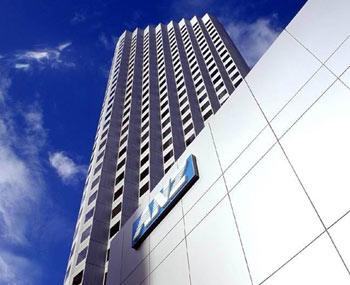
According to Banking Day, it seems the cost of borrowing for ANZ is improving in the short term (emphasis added), compared to its competitors:
On Friday, ANZ completed the sale to domestic investors of A$2 billion in fixed-rate and floating-rate bonds at spreads substantially lower than that paid by Commonwealth Bank when it opened the market two months earlier.
ANZ sold $1 billion of floating-rate covered bonds and $1 billion of fixed-rate bonds, with the spread on each tranche priced at 95 basis points over bank bills/swap for a four-year term to maturity.
When CBA established this market at the end of January it paid a spread of 175 bps over swap for five-year funds.
This easing of costs is being replicated over the Tasman, first from Banking Day again:
Meanwhile, the New Zealand corporate bond market enjoyed the busiest week of the year so far.
Rabobank New Zealand (rated AA) priced a NZ$250 million bond issue at 190 bps over swap.
Westpac New Zealand (rated AA-) priced NZ$600 million of three-year FRNs and NZ$150 million of three-year fixed rate notes at 155 bps over bank bills/swap.
This analysis from Gareth Vaughan at interest.co.nz highlights how the NZ banks (which are “our” banks – almost all owned by the big four, so maybe we should call it MegaBank NZ?), particularly Westpac NZ, are in even a better position (emphasis added):
Westpac’s mammoth domestic debt issue, split into two tranches and priced at 155 basis points over the 90 day bank bill rate and the same margin over the three-year swap rate giving interest rates of about 4.30% and 4.86% respectively, may have looked on the generous side to some of the bank’s competitors. And it was clearly embraced by institutional investors, given the maximum cap set on the issue of NZ$450 million was blown clean off.
…As Westpac Treasurer Jim Reardon told interest.co.nz, the NZ$750 million is a “pretty big chunk” of what the bank needs to borrow during 2012 in order to fund its debt maturities and forecast lending growth, therefore reducing the prospects it’ll need to go cap in hand to overseas wholesale lenders, potentially at a time of unfavourable market conditions.
ANZ last Friday raised NZ$250 million in a seven-year retail bond issue at 6.25%. That was after the bank called a separate NZ$250 million bond on March 2, that was paying 7.6%. Therefore it effectively replaced NZ$250 million of funding for 135 basis points less than it had been paying.
And there’s more of this to come. Another NZ$1.32 billion worth of bank bonds are due to be called – or reset – this year. Issued in 2007 at margins over the five-year swap rate, the four issues are currently paying interest rates ranging from 8.23% to 10.04%. Given today’s lower interest rate environment, if they’re reset investor-lenders will start receiving interest rates hundreds of basis points lower than they’re now getting, meaning the banks will be borrowing at cheaper rates. And if the banks plumb for new issues, they’ll also be at lower rates.
This is not good news for the re-inflating housing bubble in New Zealand, but good news for bank shareholders. Can the other majors expect a new trend in falling funding costs post-LTRO Europe, or rely upon increased mortgage growth in NZ to offset the anaemic growth here in Australia? Time will tell and this bears (sic) watching closely.